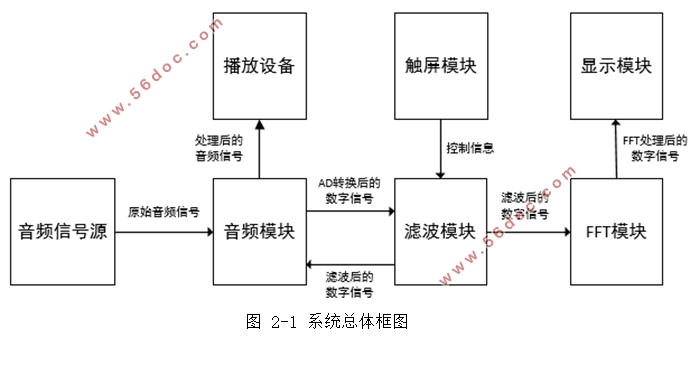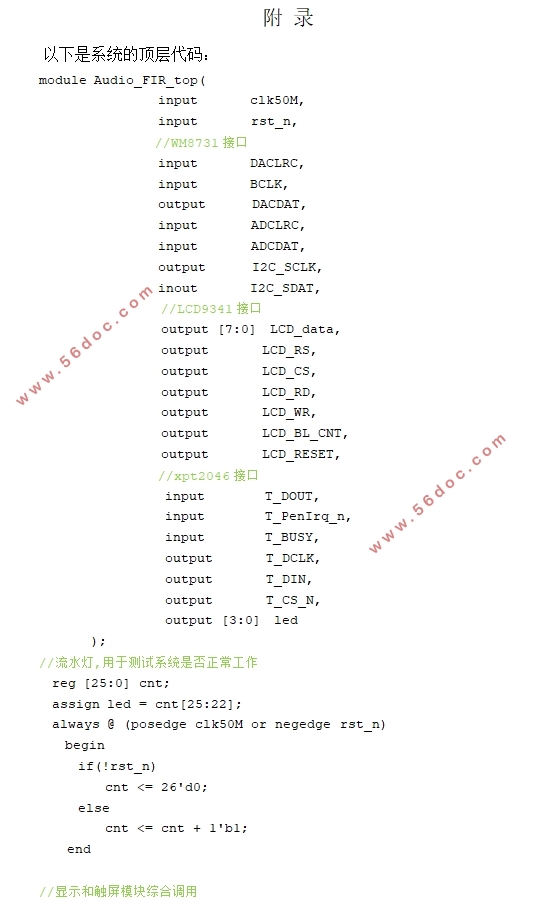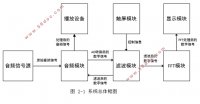基于FPGA的数字调音台设计
来源:56doc.com 资料编号:5D26833 资料等级:★★★★★ %E8%B5%84%E6%96%99%E7%BC%96%E5%8F%B7%EF%BC%9A5D26833
资料以网页介绍的为准,下载后不会有水印.资料仅供学习参考之用. 密 保 惠 帮助
资料介绍
基于FPGA的数字调音台设计(任务书,开题报告,论文12300字)
摘 要
数字调音台是一种通过数字技术实现对声音的音质、音量进行优化的现代化设备。本课题设计了一个基于FPGA的数字调音台,该设备可以通过手指按压触摸屏来选择不同的工作模式,实现对声音的低通、带通和高通滤波,达到声音的数字选通效果,并将滤波后信号的频谱实时显示在液晶显示屏上。本文首先介绍了目前数字调音台的发展现状和前景,然后介绍了系统的整体架构和设计方案。接着对其中的滤波模块、音频模块、FFT模块、触屏和显示模块的设计与实现做了详细的展示,分别介绍了各个模块的设计思路、设计步骤和模块框图。最后分析了本课题的不足之处,在音量调节和音质优化方面有待进一步改进。
关键词: 数字调音台 FPGA 滤波器 触摸屏
Design of digital mixer based on FPGA
Abstract
Digital mixer is a modern equipment to optimize sound quality and volume through digital technology. This project has designed a digital mixer based on FPGA. The equipment can work through the touch screen to select mode, realize the voice of the low-pass, band-pass, and high-pass filtering, achieve voice effect of digital routing, and can display the frequency spectrum after filtering on the LCD screen at the same time. This paper first introduces the current situation and prospect of digital modulation, then introduces the overall structure and design scheme of the system. Then the design and implementation of the filter module, audio module, FFT module, touch screen and display module are presented in detail. The design idea, design step and block diagram of each module are introduced respectively. Finally, the paper analyzes the shortcomings of this subject, which need to be further improved in terms of volume adjustment and sound quality optimization.
Key Words: Digital mixer ; FPGA ; filter ; touch screen


目 录
摘要 I
Abstract II
目录 III
第一章 绪论 1
1.1 选题背景和意义 1
1.2 国内外研究现状和前景 1
1.2.1 当前的发展现状 1
1.2.2 现存的问题 2
1.2.3 未来的发展趋势 2
1.3 课题任务 2
第二章 系统方案设计 3
2.1 系统总体方案 3
2.2 系统的功能实现 3
2.3 系统开发环境 4
第三章 硬件模块设计 5
3.1 滤波模块 5
3.1.1 滤波方案选择 5
3.1.2 FIR滤波器设计原理 5
3.1.3 滤波模块设计思路 7
3.1.4 滤波模块设计 8
3.2 音频模块 9
3.2.1 音频芯片简介 9
3.2.2 音频硬件信息 10
3.2.3 音频芯片工作模式选择 11
3.2.4 音频模块设计 12
3.3 FFT模块 15
3.3.1 FFT模块设计思路 15
3.3.2 FFT IP核调用步骤 16
3.3.3 FFT模块设计 17
3.4 触屏模块 18
3.4.1 触屏芯片简介 18
3.4.2 触屏芯片转换时序 19
3.4.3 触屏原理 20
3.4.4 触屏模块设计 21
3.5 显示模块 23
3.5.1 显示屏简介 23
3.5.2 显示屏写时序 24
3.5.3 显示模块设计 24
3.6 系统总体电路 27
第四章 结果与调试 28
第五章 总结与展望 30
参考文献 31
致谢 33
附录 34
|





